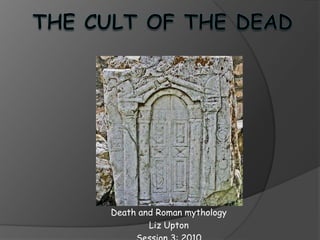
Session 3, 2010: The Cult Of The Dead, by Liz Upton
- 1. The cult of the dead Death and Roman mythology Liz Upton Session 3: 2010
- 2. What is the “Cult of the Dead”? Served as a double purpose: Dead survived in the memories of relatives and friends. Ensured comfort, refreshment and guaranteed renewal of life to their immortal spirits A regimented set of rituals formed the cult ensuring proper burial to prevent unpleasant repercussions on both the dead and living All Roman funerary practices were influenced by two notions: Death brought pollution and demanded acts of purification from survivors Leaving a corpse unburied had negative consequences on the fate of the departed
- 3. How was it practiced? Funus: covers everything taking place between hour of death and performance of the last post-burial ceremonies Once departed, immediately proceeded as following: Closest relative gave last kiss to catch soul Same relative closes deceased’s eyes and begins the lamenting process which lasted until body is disposed of Body is then washed, dressed and given coin to pay the ferryman, Charron The “lying-in-state” occurs for several days
- 4. Funerary Processions Rich and poor experienced different processions Rich = lasting up to 7 days, organized by undertakers; very important people could have a funusindictivum Poor = cremation or inhumation on cheap bier All burials took place outside the city This was part of the regulations in the Twelve Tables for sanitary precautions as well as fear of defilement Most were roadside tombs
- 5. Post-funeral practices and services rendered to the dead Only when pig’s head had been sacrificed was a grave legally a grave Upon return, suffitio rite – purification by fire and water This marked the period of cleansing The feast of silicernium eaten at the grave that night CenaNovendialis, feast similar to silicernium, takes place on the 9th day after funeral Throughout the year the dead were commemorated by funerary meals
- 6. Funerary Feasts and Offerings Ceremonial meals present in carved gravestones or painted on walls of mausolea Marks importance of feasts honoring the dead Some wealthy tombs were even equipped with kitchens Yearly offerings made during the months of April, May, June, July, August and October, excluding birthdays and other feast days Parentalia feast was reserved only for relatives of the deceased, taking place from February 13th-21st The last day, Feralia, was a public ceremonial feast day Lemuria, the superstitious feast day in honor of the kinless and hungry ghosts, the Lemures, who were considered dangerous. Worshippers would protect themselves by washing of the hands and chanting, while throwing black beans, “these I cast, with these I redeem me and mine”. Ghosts would follow and gather the beans away from the living
- 7. Feasts and Offerings con’t Roman mythology dictated that the dead could partake in their feasts Many graves had designed holes for food and drink to be filtered through to the deceased This was partly to honor the dead and mainly to help them in the afterlife Roses were regarded as pledges of eternal spring in the life beyond, they were made as offerings
- 8. Ausonius’ Epitaph of Roses “Sprinkle my ashes with pure wine and fragrant oil of spikehard: Bring balsam, too, stronger with crimson roses. Tearless my urn enjoys unending spring. I have not died, but changed my state.”
